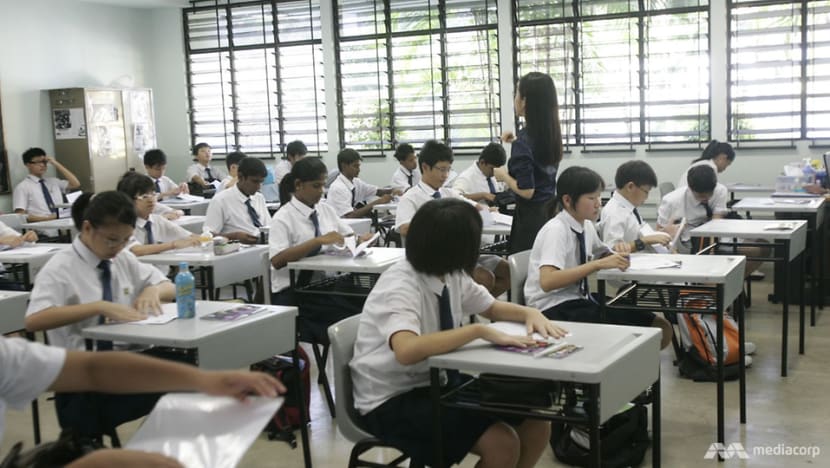commentary Commentary
Commentary: Training children to support their friends can reduce school bullying
School bullying is a worldwide problem despite all the measures in place to deal with it. Two professors shed light on the powerful role peers can play.

A group of Primary 5 students threw this note and others at a classmate in a case of bullying at Mee Toh School. (Photo: Twitter/@4YSLZ)
SINGAPORE: The problem of school bullying was in the limelight in recent months, after several highly-publicised incidents such as the case of aggression on an ITE student, and a 14-year-old student who attempted suicide after being bullied by her schoolmates.
The latter wrote a personal appeal to Prime Minister Lee Hsien Loong to look into the issue of school bullying.
What makes these cases particularly disturbing is the victimisation of vulnerable children with special needs, which in some cases seem to have persisted over time without any recourse for the victim.
Parents weighed in on the issue, prompting a response from the Ministry of Education.
READ: Is your child a bully? How parents can spot the signs and what they should do
The tried and tested method to deal with bullying is to punish the bullies and make them apologise to their victims.
Schools and the Ministry of Education reiterated their zero-tolerance stance towards school bullying, and assured students and parents that measures are in place to keep schools safe, such as stating clear negative repercussions for bullies as a form of deterrence, and offering counselling and peer support for the victims.
As a preventive measure, MOE also refreshed the Character and Citizenship Education (CCE) Curriculum by emphasising the need for students to forge a kind and caring community in schools.

Worldwide, research has shown that school bullying is a pervasive phenomenon, one that affects not just younger children in schools, but also young adults in institutes of higher learning.
Hence, bullying is not a problem that children grow out of, or that results from children being immature or weak.
Unfortunately, no magic formula exists for eliminating school bullying completely, though there are evidenced-based methods that could mitigate the impact of bullying when it occurs, or decrease the likelihood of bullying from happening in the first place.
WHAT CAN BE DONE
Several insights can be gleaned from two recent studies involving primary school children and university students in Singapore, conducted by our research teams at Yale-NUS College and the National University of Singapore.
These studies found that a combination of strong parental and peer support, as well as empathy training, might be the way forward to effectively combat school bullying across educational settings.
READ: Commentary: Many parents don’t know how to react when kids get bullied – and that’s okay
In a study involving 570 primary school children aged 10 to 12, findings showed that children’s attachment to parents helped minimise the incidence of being bullied, while friends’ reliable support in the form of protection and aid reduced the likelihood of children bullying others.
With a strong parent-child attachment, which is cultivated through spending time with the child and being responsive to their emotional needs, children are given a safe space to share their troubles at school with a trusted adult.
This provides an opportunity for parents to suggest effective strategies on how the child can cope with school bullying, ensuring continuous support at home. For example, parents may role-play with the child appropriate responses towards a bully.
Thereafter, regular check-ins with the child would help parents monitor the situation closely, providing emotional support to the child in the process. A strong attachment to parents also allows children to feel secure enough to turn to parents in times of distress, and report bullying early before it escalates further.
POWER OF PEERS
Similarly, peers who offer aid and support to one another in school facilitate the development of a positive peer culture, where children learn to engage peers without resorting to dominating strategies.
This is especially helpful for children who tend to react aggressively out of anxiety and a fear of rejection, which may turn into acts of bullying.
As students approach young adulthood, parents may no longer wield as much influence as peers do. Our study on 835 university students aged 21 to 24 showed that it was attachment to peers, rather than to parents, that buffered the effects of bullying and victimisation.

For students who were both a bully and a victim (the “bully-victims”), being highly attached to their peers reduced their anxiety to the same level as those who have not been involved in any bullying relationship.
Bully-victims are those students who bully others and at the same time are victims of bullying. Research has shown that this group of students tends to have worse mental health outcomes than those who are pure bullies or pure victims.
READ: The Big Read: No child’s play when it comes to stamping out bullying in schools
The importance of peers highlights the need for putting in place a systematic support network of peers specific to school bullying. This goes beyond the usual strategies of merely disciplining or “counselling” bullies, which may not always be viable as the first avenue of support due to the time needed to schedule an appointment with a counsellor.
A structured and targeted platform of a peer network where students are trained and equipped to handle issues related to bullying to support their peers who might be facing these challenges will help. Even young children who show the ability to offer support to others can be trained to help victims of bullying.
EMPATHY TRAINING
Apart from peer support, empathy training appears to be a promising route to reducing the effects and incidence of bullying. Our research indicates that high levels of empathy reduced the level of anxiety experienced by bully-victims, such that they were no different from students who were entirely uninvolved in bullying.
This insight is backed by other studies, which have shown that structured empathy training programmes are effective in lowering bullying rates among students as young as primary school.
READ: Bullying incident at Mee Toh School 'cannot be tolerated': Ong Ye Kung
These programmes are often conducted over several sessions, and include components such as helping students understand diverse perspectives, role-playing, and modelling empathic responses. These targeted programmes may complement the existing CCE and Social and Emotional Learning (SEL) programmes in schools.
However, the responsibility for making schools a safe haven should not rest solely on the schools themselves. Parents and families have a vital role to play in modelling good social behaviours for their children to emulate, and by being more involved in their children’s lives so that the first signs of difficulty are spotted in early stages, for both bullies and victims.
Bullying is a vicious and persistent problem. But insights from our studies highlight that a multi-pronged approach is likely to be most effective, where students are constantly exposed to anti-bullying messages at home, within their peer group, in school, and the larger community.
Cheung Hoi Shan is an Assistant Professor of Social Sciences (Psychology) at Yale-NUS College and Lee Jungup is an Assistant Professor at the Department of Social Work, National University of Singapore.














